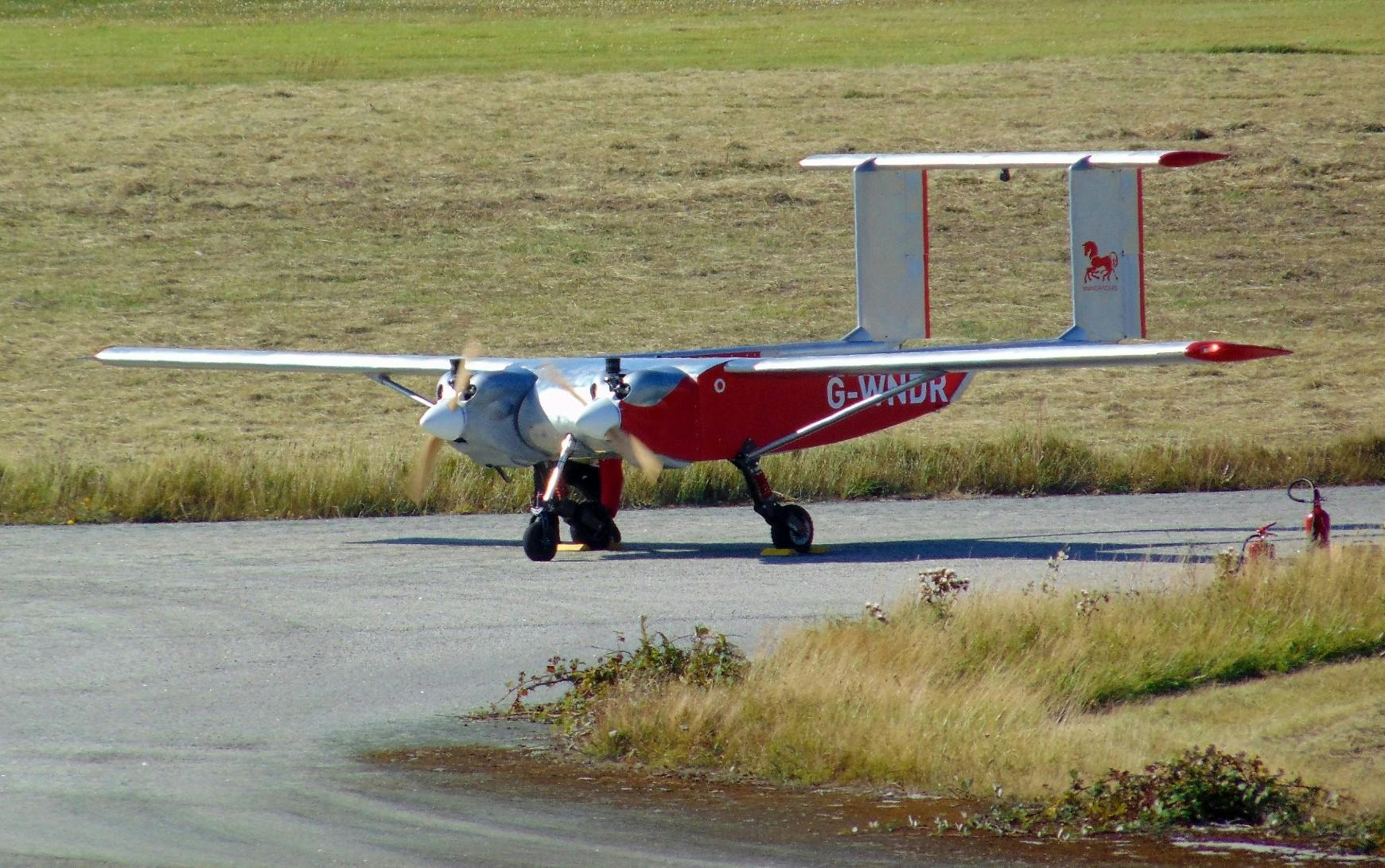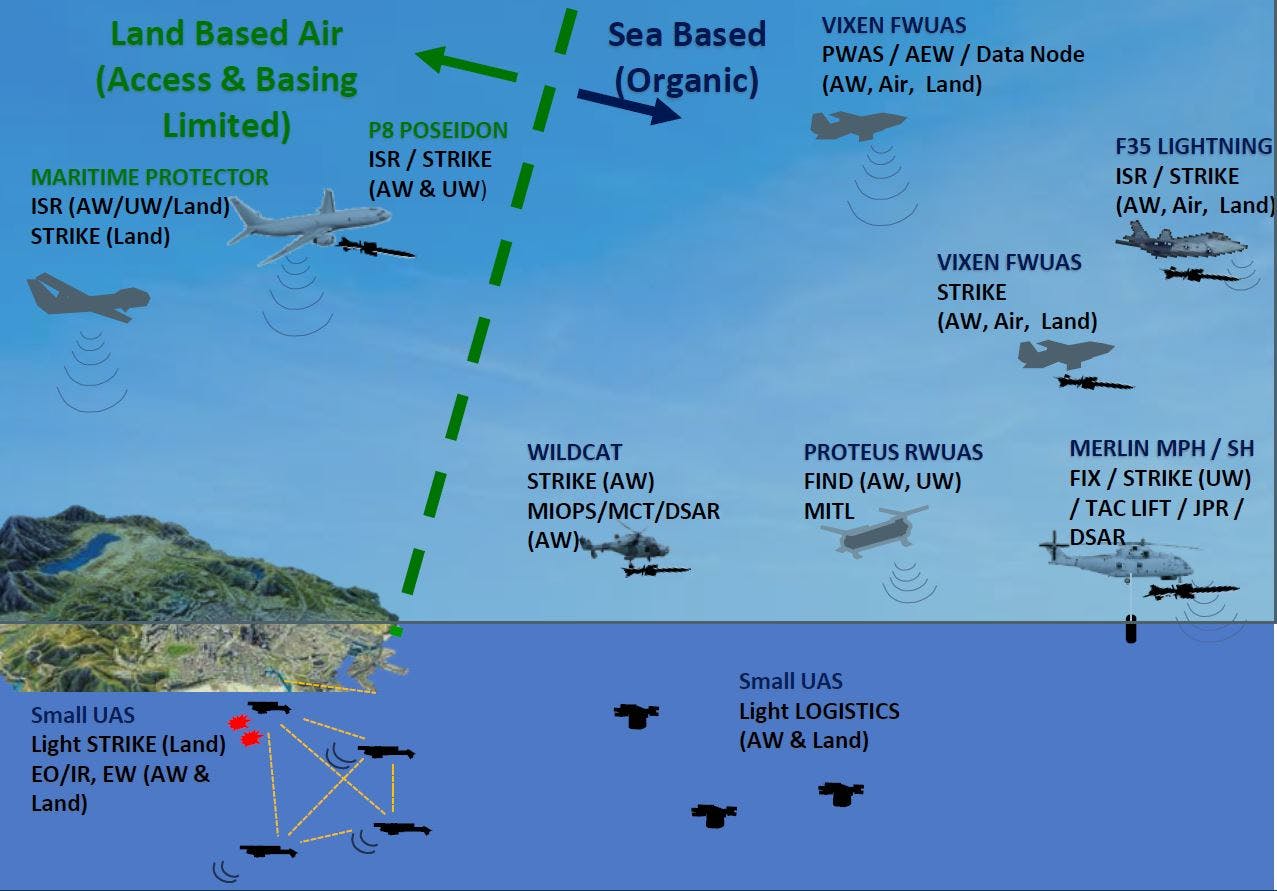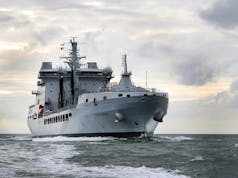The Royal Navy is looking at heavy lift drones to move payloads to ships and personnel.
According to a news release, Royal Naval Air Station Culdrose hosted the inaugural Heavy Lift Challenge, calling on drone manufacturers to showcase crewless technology which could be adapted to carry supplies and cargo to ships and personnel.
“The competition was a chance for the navy to test how it can quicken the procurement process and get off-the-shelf, readily-available tech into the hands of sailors and marines sooner. The Royal Navy and Royal Marines have already put a range of drones through their paces, demonstrating ability to lift and deliver payloads in excess of 100kgs, including a drone system used to deliver post in trials by the Royal Mail.”

The next stage is to see what equipment exists which could carry a heavier load of up to 300kg.
Royal Navy Chief Technology Officer, Brigadier Dan Cheesman said:
“This challenge is a dynamic collaboration between DE&S, industry and ourselves. Our co-creation of a ground-breaking commercial mechanism means we are able to investigate cutting-edge technology at pace and explore solutions for the Future Maritime Aviation Force and the wider Armed Forces. It’s exciting times for Defence and the market.”
James Gavin, head of Future Capability Group at DE&S, added:
“This project is about exploring emerging technology which could be of future use to the Royal Navy and other front-line commands and new acquisition approaches li ke RAPSO (Rapid Agile Prototyping, Scaled for Operations) to ensure any operational advantage can be delivered to our UK Armed Forces at pace.”
ke RAPSO (Rapid Agile Prototyping, Scaled for Operations) to ensure any operational advantage can be delivered to our UK Armed Forces at pace.”
Organised by the Navy’s drone experts 700X Naval Air Squadron, Defence Equipment and Support and the Office for the Chief Technology Officer RN, the competition saw two companies – Malloy Aeronautics and W Autonomous Systems – awarded £300,000 contracts to develop their remotely piloted air systems (RPAS) to lift beyond 200kg, you can read more on the competition here.
Where will this lead?
According to a presentation on the ‘Future Maritime Aviation Force’, the Royal Navy will move many capabilities currently delivered by crewed aircraft to drones.
The presentation states that “by 2030”, the Royal Navy will have:
“Added mass to the Carrier Wing with additional LIGHTNING and medium FWUAS (VIXEN)” and “will have rejuvenated the Merlin fleet, to synchronise with replacement capabilities, transferring PWAS/AEW/Data Node to VIXEN and ASW FIND to medium RWUAS (PROTEUS)”.
The text accompanying the ‘By 2030’ slide is as follows:
“We will have added mass to the Carrier Wing with additional LIGHTNING and medium FWUAS (VIXEN). We will have rejuvenated the Merlin fleet, to synchronise with replacement capabilities, transferring PWAS/AEW/Data Node to VIXEN and ASW FIND to medium RWUAS (PROTEUS). Wildcat will be augmented with additional ASUW/Littoral FIND capability, also by PROTEUS. Maritime Protector will provide complementary support where teamed with POSEIDON in the North Atlantic. Small UAS capabilities will be spirally developed to encompass EW,UW and target training support.
Successful payload and weapon integration will also be key to the success of FMAF.
In 2030, medium organic UAS will deliver most FIND in the Littoral and Maritime, teamed with crewed air for FIX/STRIKE, and complemented by Maritime Protector. ASW Merlin will regain mass with the transfer of AEW capability to an alternate platform. Together with enhanced FW in the Carrier Air Wing, Maritime Aviation will be reconstituted to match evolving peer threats.”
You can read more about wider plans here.
Royal Navy looking at fixed-wing carrier based drone for AEW















There is clearly a lot of research and development, trials and testing being undertaken here, which is very encourgaing. However, I do worry that the procurement system is not yet able to exploit these systems in a timely manner.
Given the number of articles on here and elsewhere it seems to me that the RN is looking for a payload in the 300kg weight bracket, which is slightly more than the weight of a Stingray torpedo…
I would like to see the navy adopt a 300kg capable quadcopter sooner rather than later. Even if such an ‘adoption’ was only in small numbers it would prove that the procurement system was capable of getting the job done at ‘pace’…
Fixed wing drones of any kind of size will likely require changes to the carriers so are in a different ball game all together. quadcopters or other VTOL drones could be flown from OPV’s, escorts and unmodified carriers, so easier to deploy early and prove the ‘system’ can work.
Cheers CR
Yes, a quick purchase of some Malloy drones to operate at torpedo droppers/delivery vehicles sooner rather than later would be good. There’s nothing like actually using the kit to see what you really require.
Interestingly the snazzy drawing gives P8 an above and underwater strike role, were there plans to purchase anti ship missiles for it (in the light of the other cancellation)?
Hi Armchair Admiral,
The P-8 is cleared to use the air launched version of the Harpoon something the UK has not bought, so I don’t think we have an above water capability as yet. Whether there are plans to integrate the FC/ASW in the future, who knows?
I think there will be moves to integration either the Stingray or the new Light Weight Torpedo at some point as well, but not for some time I think.
Cheers CR
I believe that Norway is moving to integrate JSM, and the US want LRASM on P-8 too. I could see us maybe showing some interest in the former, but the latter is too expensive I’d expect.
Also we need a vehicle that is capable of delivering spear F35 and Merlin engines ship to shore/ ship to ship at the moment the USN are starting to use the modified Osprey (it can now fit an F35’s engine through its rear access doors) as the new COD vehicle the MoD is a bit reluctant to go down the same path due to costs but that leaves a massive whole in the RN’s logistical support.
Makes no sense to buy and support a (very expensive and about to go out of production) new platform for this niche role. Fit Chinook with a refuelling probe (and Merlin HC4), and fit a few A400 as tankers and hey presto problem solved in the absence of USMC / USN cooperation.
I would have thought it would be better to have a ship born aircraft such as the Osprey that can multi task in that it has a 1500 mile range and can also be used to deploy personnel ashore plus I do not think the Chinook can fit a F35 engine on board as the new version of the Osprey had to have its rear door widened to allow the engine to pass through I may be wrong but I believe that the Chinook’s rear doors are not wide enough. The USN and USNC have just orders a load more Osprey’s so it will not be going out of production any time soon.
I fear if we bought Osprey F-35 numbers would suffer fatally.
The two Carriers are supposed to be a show case for STOVL aircraft so I would have thought having a flight of Ospreys on each of the carriers for COD and personnel transport would augment the ships capacity but alas I tend to agree with you about the old bean counters
Personally, I think we should invest our scarce resources in the highest priotities and in British industry, of which COD and Osprey are neither. If we need to showcase anything it should be British or have British content. I’d rather they invested in Project Vixen.
You are 100% correct we should be investing in British industry but as the government of the day abandoned the harrier and any follow on development apart from the 10% investment in the F35. Along with zero investment in a logistical support aircraft for the fleet. We have gone down the STOVL route with our carriers and it is too late to turn back so we must put US/UK (90/10) made aircraft on them as they are the only one with a STOVL 5th generation aircraft to put onto a top of the range aircraft carrier, but we need support aircraft as well and unless we are prepared to invest in our own aircraft industry and design and build such aircraft (I think the politicians would rather donate their left testicular to science than give more money to the Forces) then we must do the next best thing and try to get a deal out of the yanks to get a few aircraft on our carriers to help out with the logistical support for carrier operations. I do not think that drone’s will be capable of carrying personnel (or the personnel have the confidence in them) for some time to come plus with a 300KG lift capacity they will not be able to lift anything of any size.
Great idea and all done already except that MOD signed up to the Tanker team that they would be sole suppliers for such a service meaning we cannot use the A400’s for such even if they had the kit. Short sighted as always in MOD and of course continue to try and reinvent the wheel when there are some good real full size systems out there. Look at the USMC!!!!
We should buy the Voyagers outright and cancel that contract, or contract Air Tanker to provide a few more A400s with tanker fit..
Could we bring all 14 into regular service to both boost tanker capability and mitigate the drop in transport capacity?
How much fuel could a Chinook carry and to what range?
Jolly good!
Carry passengers…..mmmmm, who would be willing to get into a plane without a pilot.
Did read like that at first, but its about supplies to personnel not supplying the personal themselves … at least for the foreseeable anyway.
Pipistrel Nuuva V300?
How necessary is this capability? The carriers are unlikely to carry the designed full complement of F35s any time soon,if ever. So there should be ample space to carry spares including engines. Rotary UAVs will have the same range limitations as helicopters so what benefit do they offer other surface vessels?
The bigger ambition for Vixen is going to be challenging both technically anf financially. Heavy weight transonic UCAVs will massively complicate flight operations and the RN has zero experience of CATOBAR. Look how long it has taken to regenerate STOVL operations for which we had recent experience and the help of the USMC.
This seems more fantasy fleet than a serious plan..
What we need is a way to refuel our F-35Bs and MQ-25s are no solution since they can’t carry a meaningful amount of fuel. They can only refuel 1 F-35B which is useless if a carrier group is staying out of the range of DF-26 or Kinzhal. Calling 300kg “heavy lift” is laughable.
Anyone else struggle to keep up with the proliferation of drone projects at the moment? Feels very much like after years of lagging behind the MoD are now funding R&D into UAV’s for all manner of roles to make up for a lock of withering or abandoned capabilities.
Protector, Watchkeeper, handheld drones for The Army, Vixen for Royal Navy AEW, Banshee for target practice, now heavy lift and tanker solutions….innovation is great but is this a familiar case of the services operating in their own silo’s and duplicating solutions again?
The graphic also shows Merlin with an air to surface missile of some kind. That was news to me too.
Really the UAVs will make sense to fulfil the gaps left behind by the retirements of the Fairey Gannet AEW.3, Fairey Gannet COD.4 and Blackburn Buccaneer S.2 in the late 1970s by politicians making the wrong decision that the UK didn’t Aircraft Carriers
So 100kg-300kg is considered heavy lift now?